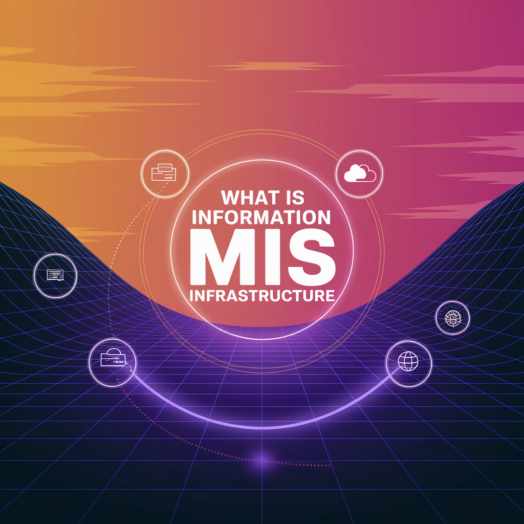So, what is an information MIS infrastructure, and what are the characteristics that support it? Also, have you been surfing the internet for a long time now? If so, then here you are, scrolling through the best informative piece for the same.
Therefore, let’s delve into the following segments without wasting further moments.
What Is An Information MIS Infrastructure?
At this particular time, if you are looking for what best describes an information MIS infrastructure, an Information MIS (Management Information System) Infrastructure refers to the underlying framework that supports the collection, processing, storage, and distribution of data within an organization. It ensures businesses have reliable, secure, and scalable technology systems to manage their information efficiently. The information MIS infrastructure determines how important and where the data is preserved and secured.
In brief, according to Quizlet, enterprise architects concentrate on three main areas. Moreover, it is done while holding the firm’s MIS infrastructure. Moreover, these are as follows:
Therefore, the information infrastructure offers three significant areas of support. These are the recovery and backup, business continuity, and disaster recovery plans.

Components of an MIS infrastructure
A Management Information System (MIS) infrastructure is critical to any organization’s overall IT system. It comprises hardware, software, and networking components that provide information to management and other decision-makers. Understanding the elements of an MIS infrastructure is essential in designing an effective system that meets the organization’s needs.
Hardware components
They include servers and storage devices. Computer systems consist of desktops, laptops, tablets, and other mobile devices end-users use to access information. Servers provide a central location for data storage, processing, and dissemination, while storage devices store the data for retrieval and processing.
Software components
It includes operating systems, database management systems, and various application software. Operating systems provide the foundation for running software programs, while database management systems provide the ability to manage data storage, retrieval, and processing. Application software is specific software designed to meet the particular needs of an organization.
Networking components
This ensures that MIS infrastructure connects all the hardware and software components to enable communication between the various parts. This includes network devices such as routers, switches, firewalls, cabling, and wireless connections.
Security components
This is a critical part of an MIS infrastructure. These include access control systems, data encryption, and backup and recovery systems to protect the organization’s information assets from unauthorized access, theft, or loss.
People are an essential component of an MIS infrastructure. They include end-users who use the system to access information, IT personnel who design and manage it, and other stakeholders who use it to make decisions.
Importance of MIS Infrastructure
MIS infrastructure is crucial because it enables organizations to manage and process their data, enhancing decision-making processes efficiently. It also supports operations, improves productivity, and ensures that data is accurate, timely, and available to those who need it. In today’s business environment, where technology plays an essential role, having a robust and reliable MIS infrastructure is vital for the success of an organization.
Functions of Information MIS Infrastructure
Support for Operations
MIS infrastructure supports day-to-day operations by ensuring that data is available and accessible to all users who need it. It also supports automating routine tasks like payroll processing and inventory management.
Support for Decision Making
MIS infrastructure supports decision-making processes by providing decision-makers with accurate, timely, and relevant data. It also helps decision-makers analyze data, identify trends, and make informed decisions.
Support for Competitive Advantage
MIS infrastructure can provide a competitive advantage by enabling organizations to process and analyze data faster and more accurately than their competitors. It also allows organizations to innovate and develop new products and services.
Challenges of Information MIS Infrastructure
Security
Security is a significant challenge for MIS infrastructure. Organizations must ensure their data is secure from unauthorized access, theft, and cyber-attacks. They must also comply with regulations and standards related to data privacy and security.
Accessibility
Accessibility is another challenge for MIS infrastructure. Organizations must ensure that data is available to those needing it, regardless of location or device. They must also ensure the infrastructure is scalable and can handle increased demand.
Scalability
Scalability is a challenge for MIS infrastructure because organizations must ensure that their infrastructure can handle increased demand as the organization grows. This requires regular maintenance and upgrading of hardware and software components.
Which Characteristics Support The Information MIS Infrastructure?
After looking at the gist of an information MIS infrastructure, it is time to grab the information over the characteristics supporting it.
Hence, there ain’t need to fret if you are unaware of these characteristics. It is because the following table will help you grasp all the necessary information. So, aren’t you curious?
If so, what are you waiting for? Likewise, let’s delve into the table below to learn more.
| Which characteristics support the information MIS infrastructure? |
| Accessibility |
Disaster Recovery Plan |
Usability |
Grid Computing |
Reliability |
Visualization |
Maintainability |
| Backup and Recovery Plan |
Availability |
Business Continuity Plan |
Portability |
Cloud Computing |
Scalability |
Furthermore, according to the How To, every MIS infrastructure has seven significant characteristics. Therefore, from the table mentioned above, let’s recheck them as they are discussed below:
-
- Accessibility
- Usability
- Reliability
- Scalability
- Portability
- Availability
- Maintainability
Uses of MIS
MIS is a critical tool for organizations of all sizes and industries, providing a range of benefits that can improve operational efficiency, decision-making, and ultimately, profitability.
With MIS, you can streamline your organization’s processes, from data entry to analysis and reporting. This means less time spent on manual tasks and more time for strategic planning and execution. MIS also provides accurate and timely information, enabling faster decision-making and reducing the risk of errors.
However, MIS is not just about efficiency – it also helps organizations gain a competitive advantage. By leveraging data and analytics, MIS enables organizations to identify opportunities, trends, and patterns that would otherwise be difficult to uncover. This means better insights into customer needs and preferences, market trends, and competitor strategies – all of which can help you stay ahead of the curve.
MIS is also a key enabler of collaboration, allowing teams to collaborate more effectively and share information effortlessly. This can improve communication, reduce duplication of effort, and enhance overall productivity.
MIS has something to offer whether you’re a small business or a large enterprise. From improving operational efficiency to enhancing decision-making and gaining a competitive advantage, MIS can help take your organization to the next level. So why wait? Invest in MIS today and start reaping the benefits.
Best Practices for Information MIS Infrastructure
Regular Maintenance
Regular maintenance of MIS infrastructure is critical to ensure that it is running smoothly and efficiently. This includes updating software and hardware components, monitoring performance, and addressing.
any issues or vulnerabilities in the system.
Integration with Business Processes
MIS infrastructure should be integrated with the organization’s business processes to support and enhance these processes. This requires a deep understanding of the organization’s operations and objectives.
Continuous Improvement
MIS infrastructure should be continuously improved to meet the organization’s changing needs. This requires monitoring and analyzing performance metrics, identifying areas for improvement, and implementing changes as needed.
FAQs
- What are the benefits of MIS infrastructure for an organization?
- MIS infrastructure enables organizations to efficiently manage and process data, enhance decision-making processes, support operations, and improve productivity.
- What are the components of MIS infrastructure?
- The components of MIS infrastructure include hardware, software, and data management technology.
- What are the challenges of MIS infrastructure?
- The challenges of MIS infrastructure include security, accessibility, and scalability.
- How can organizations ensure that their MIS infrastructure remains robust and reliable?
- Organizations can ensure that their MIS infrastructure remains robust and reliable by following best practices such as regular maintenance, integration with business processes, and continuous improvement.
- What is the role of MIS infrastructure in decision-making processes?
- MIS infrastructure supports decision-making processes by providing decision-makers with accurate, timely, and relevant data and helping them analyze data and make informed decisions.









 Evan John
Evan John